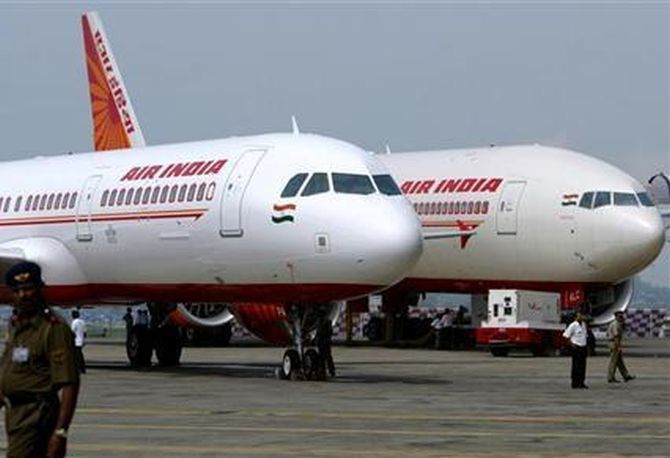A total of Rs 30,000 crore was allocated for five years to Air India by the United Progressive Alliance government in its second term, notes Anjuli Bhargava.
 What about the elephant in the room? That's the question the aviation industry is asking about the draft policy announced by the government in October.
What about the elephant in the room? That's the question the aviation industry is asking about the draft policy announced by the government in October.
How can a policy on aviation in India be silent on Air India, which accounts for most of the annual budget of the civil aviation ministry (close to Rs 6,000 crore) every year?
A total of Rs 30,000 crore (Rs 300 billion) was allocated for five years to Air India by the United Progressive Alliance government in its second term.
The question being asked is whether another Rs 30,000 crore is planned to be spent over another five years to keep Air India flying since the policy is silent on the national carrier's future.
"It will not be a surprise if taxpayers are asked to finance another five years of running Air India," a former director of the airline says.
"This strikes me as the most glaring omission in the draft policy. How can we ignore the biggest problem staring us in the face? With Rs 6,000 crore (Rs 60 billion), the government can set up three new airlines every year."
If that is one big omission, another is the silence on reform of the Directorate General of Civil Aviation (DGCA) - specifically, separating economic regulation from safety regulation.
One of the better reports on the sector, the Naresh Chandra Committee report, had suggested separation of economic regulation from safety regulation as well as setting up a "Civil Aviation Authority".
At present, the DGCA takes care of both safety and economic regulation - and fails miserably at the latter.
Every time airfares rise above a certain level, the DGCA jumps in and claims to monitor them without having either the technical expertise or the staff to do it.
"Every time fares rise, the DGCA gives airlines a rap on the knuckles and then pipes down; in effect very little happens," a former aviation secretary says.
"I am not saying airfares should not be regulated but if the government is keen on any kind of economic regulation, the DGCA is not the body to do it."
Economic regulation is necessary to lay down entry barriers for the sector (too often in the past, players, who lacked the financial muscle, were allowed to come in, but they had to shut shop after going bankrupt), make exit easier for airlines, monitor new ways to raise revenues by airlines, ensure that airlines compensate passengers for delays and other omissions according to the guidelines, and so on.
"The issue of effective control of airlines, where foreign airlines have a stake in an Indian carrier, keeps cropping up," says a former director general of civil aviation. "An economic regulator can be asked to keep track of all this."
He says there has been virtually no evolution of economic regulation in civil aviation in India, primarily because the government does not want to hand over control to an independent authority.
The bidding route proposed in the draft doesn't have many takers either. Industry sources were of the view that it may not be workable since bilateral rights are negotiated between governments and allocated by governments to their own carriers.
"It's not as if anyone can bid and he will be able to utilise these rights," points out a former Air India director.
"Bidding of this kind - if it happens - would be unique (in the history of world aviation) and we have to see how the idea sits with other governments."
Moreover, it would, at best, be limited as there are only a few countries in the 5,000-km range with multiple carriers who can bid (countries such as Qatar and Bahrain have only one airline coming into India). Outside the 5,000-km range, traffic rights go begging.
In the past, Air India would charge royalty from foreign airlines, which wanted to fly more for use of their unused traffic rights.
But the deals were commercially negotiated between two airlines - on an airline-to-airline basis.
The system was frowned upon and discontinued since, as with all such deals, several people - both in the government and Air India - were said to have made a lot of money under the table.
While the proposal to charge a cess and build a corpus for subsidising connectivity to remote areas is sensible and well-intended, the lack of clarity on it is likely to render it useless.
One, the policy doesn't define the term "remote" and this leaves it open to political influence.
The network or cities to be covered by the subsidy have not been mentioned anywhere.
Two, the proposed cap of Rs 2,500 for fares appear to be just a number pulled out of a hat.
And three, the draft talks of regional airlines and scheduled commuter airlines as if the two were interchangeable when, in fact, they are two very different animals.
Besides Air India and the DGCA, the draft is silent on reform of the Airports Authority of India (AAI) as well. Reformer, heal thyself.
(A majority of the people in the industry spoken to for this piece - 18 to be precise - chose to remain anonymous as they are an integral part of the industry. The selection included CEOs and commercial heads of some operating airlines; Air India directors, both retired and current; two former aviation secretaries; a former director general of civil aviation; some pilots; AAI officials, among other industry professionals and consultants.)












 © 2025
© 2025